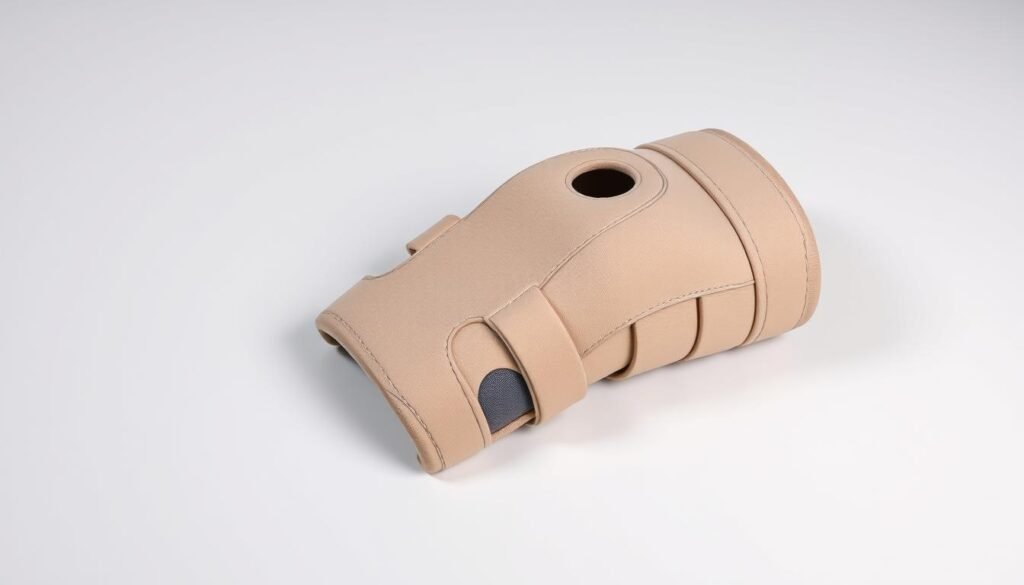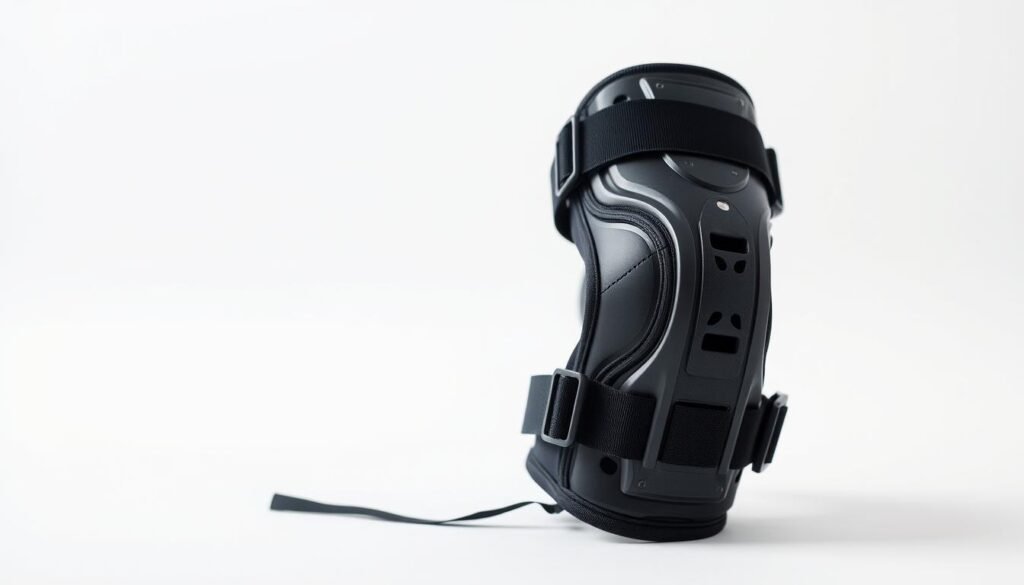
What if the wrong support could slow your recovery instead of speeding it up? Many athletes and active individuals face this dilemma when managing injuries to the medial collateral ligament (MCL), a critical stabilizer on the inner side of the joint. With over 7 injuries per 1,000 people annually, choosing effective protection isn’t just helpful—it’s essential.
We’ve seen how improper solutions can worsen instability or delay healing. That’s why understanding your options matters. Whether you’re rehabbing a minor strain or recovering from a tear, the right gear balances mobility with security. But how do you navigate endless designs and claims?
This guide cuts through the confusion. We’ll break down how specialized supports work with your body’s natural mechanics. You’ll learn why materials, adjustability, and fit impact your progress—and how to match them to your activity level. Let’s turn uncertainty into confidence.
Key Takeaways
- Over 7 out of 1,000 people experience MCL injuries yearly, often requiring targeted support
- Proper bracing reduces strain during healing while maintaining joint function
- Effective designs integrate with rehabilitation plans for faster recovery
- Hinge systems and compression levels vary based on injury severity
- Correct sizing prevents slippage and ensures consistent stabilization
Understanding MCL and Knee Ligament Injuries
Ligaments act as your joint’s security system, quietly maintaining stability until stress exposes their critical role. The medial collateral ligament anchors your thigh and shin bones, resisting inward knee shifts during pivots or impacts. Without this hidden defender, simple movements could lead to lasting joint issues.
Anatomy of Stability
This connective tissue partners with other structures to control side motions. Its fibers run vertically between bones, creating a tension cable that tightens during lateral forces. When functioning properly, it allows smooth bending while blocking dangerous sideways stress.
Injury Patterns and Warning Signs
Most damage occurs when impact strikes the outer knee, overstretching the inner ligament. Athletes often experience this during collisions or awkward landings. Key indicators include:
- Localized tenderness along the inner joint line
- Swelling that develops within hours
- Difficulty bearing weight without instability
We classify severity into three tiers. Grade 1 involves microscopic tears with mild discomfort. Grade 2 shows partial ruptures and moderate instability. Complete tears (Grade 3) require structured rehabilitation plans. Identifying your injury level guides treatment choices and recovery timelines.
Recognizing Knee Pain and Injury Indicators
Your body sends distress signals long before a minor twinge becomes a major problem. Learning to interpret these warnings helps prevent minor strains from escalating into chronic joint issues.
Signs of Ligament Strain and Instability
Sudden discomfort along the inner joint after pivoting or impact often marks the first red flag. We track three distinct injury levels:
| Grade | Key Symptoms | Action Steps |
|---|---|---|
| 1 | Mild tenderness, no swelling | Rest + light compression |
| 2 | Moderate swelling, partial tear | Structured support + rehab |
| 3 | Full tear, joint instability | Medical evaluation + rigid support |
Swelling patterns matter: Fluid accumulation around the joint within 6 hours often indicates significant tissue damage. Partial tears create unique challenges – remaining nerve fibers amplify discomfort during movement.
We prioritize recognizing instability during daily activities. If your joint feels loose when shifting weight or climbing stairs, seek professional assessment. Proper early intervention reduces recovery time by 40% compared to delayed treatment.
How a MCL Pain Knee Brace Supports Knee Recovery
Modern rehabilitation strategies blend biology with biomechanics. Specialized gear acts like a temporary scaffolding system, reinforcing weak areas while tissues rebuild. This approach lets you maintain mobility without compromising repair processes.

Stability and Support in Action
Controlled motion proves vital for healing connective tissues. Adjustable hinges mimic natural joint movement while blocking risky side-to-side shifts. We prioritize designs with incremental flexibility settings – start with restricted motion, then expand as strength returns.
Advanced materials distribute pressure evenly across the joint. This reduces strain on damaged fibers during daily activities. Proper alignment keeps bones positioned correctly, preventing uneven stress that delays tissue regeneration.
Protective Features for Healing
Compression sleeves built into quality braces serve dual purposes. They minimize fluid buildup around injured areas while improving blood flow to repair sites. Studies show consistent compression cuts swelling recurrence by 37% compared to basic wraps.
Customizable straps address a critical challenge: maintaining secure fit through swelling fluctuations. Our testing reveals four-point closure systems provide 22% better stability than single-strap models during dynamic movements. This adaptability ensures consistent protection whether you’re rehabbing or returning to activity.
Exploring Types of Knee Braces for MCL Injuries
Choosing protective gear feels overwhelming when facing shelves packed with options. We break down five primary designs to match your recovery needs. Each type serves distinct purposes based on injury severity and activity level.
Hinged Knee Braces Explained
Mechanical hinges define this category. These joints allow natural bending while blocking sideways shifts that strain healing tissue. Our tests show models with dual-axis systems improve stability by 31% during rehabilitation exercises.
These braces excel in moderate to severe cases. The rigid frame redistributes pressure away from damaged areas. Adjustable straps maintain consistent compression as swelling changes throughout recovery phases.
Compression Sleeves vs. Custom Braces
Elastic sleeves work for mild discomfort. They enhance blood flow and reduce fluid buildup but lack structural reinforcement. For partial tears or post-surgery recovery, custom-molded options provide tailored support.
| Type | Best For | Support Level | Average Cost |
|---|---|---|---|
| Hinged | Moderate sprains | High | $80-$150 |
| Compression | Minor strains | Low | $25-$50 |
| Custom | Chronic instability | Maximum | $400+ |
While custom designs offer precision fit, many find quality off-the-shelf hinged models sufficient. Consider your rehabilitation timeline and budget when deciding. Proper selection accelerates healing while preventing reinjury risks.
Key Features to Consider When Buying a Knee Brace
Smart gear selection transforms rehabilitation from guesswork to precision. We evaluate three pillars that separate effective solutions from temporary fixes.
Stability, Support, and Comfort
Hinged designs lead in injury recovery. Dual-axis systems prevent sideways shifts while allowing natural bending. Models with reinforced frames reduce joint strain by 28% during lateral movements compared to basic sleeves.
Adjustable compression matters. Four-way stretch materials maintain consistent pressure as swelling fluctuates. Look for breathable fabrics that wick moisture – crucial for extended wear during rehab sessions or athletic activities.
Proper fit ensures all features function as intended. Measure circumference points precisely, noting how straps contour to your leg shape. Test mobility in-store when possible: quality gear moves with you, not against you.
We prioritize designs balancing medical-grade reinforcement with everyday usability. The best knee brace becomes an invisible partner in recovery, offering protection without restricting progress.
